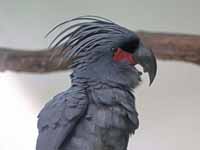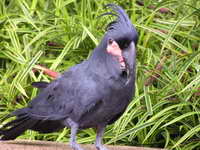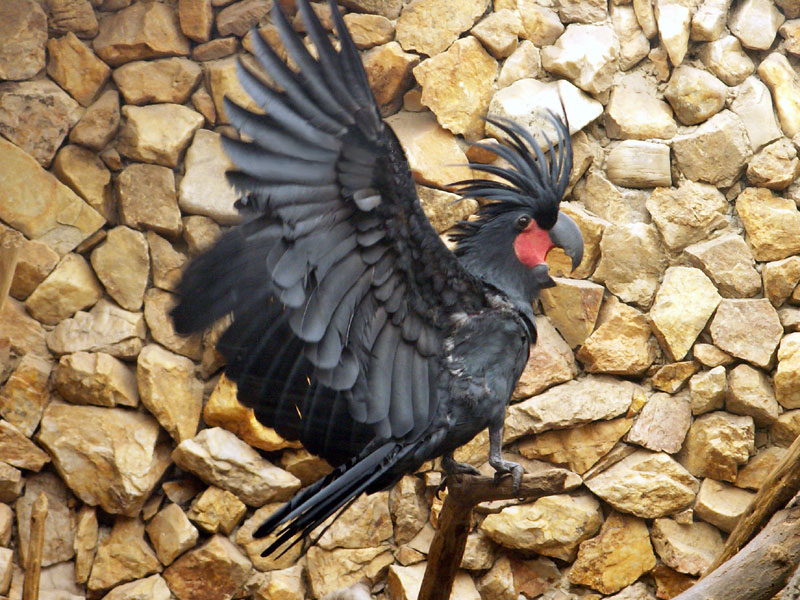Psittaciformesorder which contains parrots and their allies. Their family name, Cacatuidae, evolved from the Malaysian name for cockatoo, kakaktua. Species in this order are found in most warm and tropical regions. The greatest diversity of parrots is found in South America and Australasia. Characteristic features of parrots include a strong curved bill, an upright stance, and strong legs. Like woodpeckers, they have 2 toes pointing forward (digits 2, 3) and 2 toes pointing backward (digits 1, 4). Most parrots are predominantly green, with other bright colors. They generally exhibit little or no sexual dimorphism. The most important components of most parrots' diets are seeds, nuts, fruit, buds and other plant material. Almost all parrots nest in tree holes. They can be afflicted by psittacine beak and feather disease (PBFD). This viral infection causes feather loss and beak malformation and reduces the bird's overall immunity. Parrots are some of the most intelligent birds, and the ability of some parrot species to imitate human voices enhances their popularity as pets.
In addition to the cockatoo family Cacatuidae there is also the parrot family Psittacoidea and the New Zealand parrot family Strigopoidea.
All cockatoos have significant crests and curved bills. Thier plumage is generally dull: white, grey or black. Their crest, face, and or tail may have more striking colors. Most cockatoos are larger than true parrots. The cockatiel, which is a memeber of the cockatoo family, is an exception as it is quite small. Two of the cockatoo genera contail most of the family members. The five species iin Calyptorhynchus have mainly black plumage. Cacatua contains 11 species all of which have mainly white plumage. There are five more single species genera which brings the total family members to 21.
Cockatoos, not including the cockatiel, are from 30 to 60 cm in length 300 to 950 grams in weight. Males and female do not differ in size or plumage. The mature cockatiel is can be as small as 29 cm long and 80 to 100 grams in weight. One difference the cockatoos have from true parrots is their erectile crest which is raised when they land or when they are aroused. Another difference is that parrots are brightly colored and the cockatoos are not.
Cockatoos eat seeds, fruit, tubers, insects, and flowers. They often feed in large flocks, particularly when ground-feeding. Cockatoos are monogamous and nest in tree hollows. Logging can thus adversely affect them, but some have adapted well to humans and are considered agricultural pests. Another threat to cockatoos is capture for pets. The most popular pet of the family is the cockatiel as it is the easiest to maintain. Fortunately, the conservation status of that species is Least Concern so aviculture does not threaten its survival.
The cockatoo bill is kept sharp by rasping the jaws together when resting. They dehusk seeds by moving the jaws sideways. The tongue holds the seed against the lower jaw while the upper jaw moves across the seed like a file. Cockatoos maintain their feathers with frequent preening throughout the day. They also preen other birds' feathers that are otherwise hard to get at. Molting occurs a period of time so that flight is not disturbed. For most cockatoo species, it takes about 6 months for all flight feathers to be replaced. For the black cockatoos it takes 2 years! From the human perspective, cockatoos do not have pleasing voices; their calls are loud and harsh. The calls are used for warnings, identification, and to keep cohesion of their group.
Cockatoos are social and gather to eat, roost, and travel together. Their flocks may number in the hundreds or even thousands. Flock size tends to be higher for species that live in open spaces. It is also related to weather conditions; in time of drought flock size increases. They nest in tree hollows and have 2 to 8 white eggs. Incubation takes 20 to 29 days and fledging takes another 5 to 11 weeks. In both case, the larger species take more time.
Most species of cockatoos have a stable population and not threatened by humanity. However, eight species are challenged because of habitat modification or distruction caused by humans. On the other hand, some species that prefer open habitats have benefited from habitat modification and thrived so much that they are considered pests due to damage of trees, grains, and fruits.
Genus Cacatua
The cockatoos and corellas have white plumage that is tinged with pink or yellow in some species. All species have a crest, the size varying from species to species. When erect there is often yellow visible in the crest. They generally eat seeds, fruits, buds, and bulbs.
Cockatoo,_Blue-eyed Cacatua ophthalmica
Description: The blue-eyed cockatoo has mainly white plumage, a blue eye-ring, and a yellow and white mobile crest. The bill is black and the legs are dark grey. It has a much bolder blue eye-ring than the sulphur-crested cockatoo or the yellow-crested cockatoo. It is the only cockatoo in the Bismarck Archipelago. The blue-eyed cockatoo is 45 to 50 cm long and weights 550 to 570 grams.
Range: New Britain in Papua New Guinea.
Habitat: Lowland forests Their nest are usually located in high trees, averaging 40 meters high.
Diet: Mainly seeds, nuts, berries, and fruits. Also insects and their larvae.
Conservation status: The blue-eyed cockatoo is listed as Vulnerable. The population is around 10,000 and declining due to rapid clearing of lowland forests.
Image by: 1) Katerina_Tvardikova 2, 3) Christian Strobbe - Walsrode Bird Park, Germany 4) madlemursRange: New Britain in Papua New Guinea.
Habitat: Lowland forests Their nest are usually located in high trees, averaging 40 meters high.
Diet: Mainly seeds, nuts, berries, and fruits. Also insects and their larvae.
Conservation status: The blue-eyed cockatoo is listed as Vulnerable. The population is around 10,000 and declining due to rapid clearing of lowland forests.

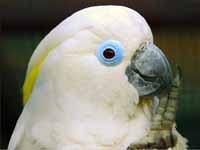
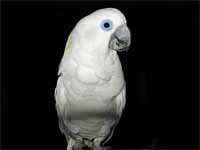
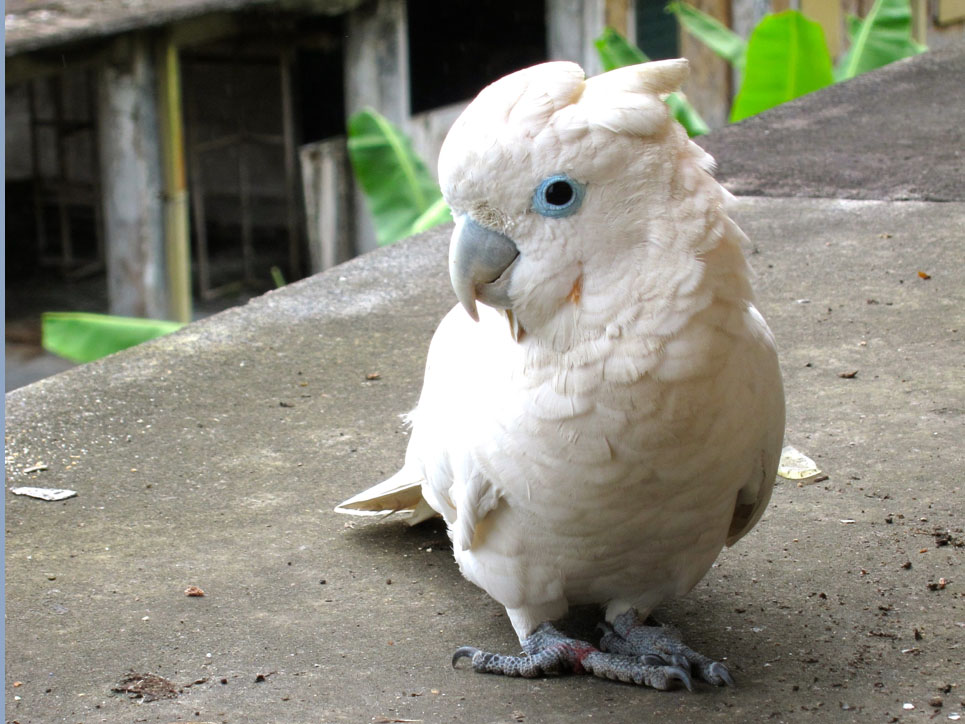
Cockatoo, Ducorps' Cacatua ducorpsii
Description: The Ducorp's cockatoo, also known as Solomons cockatoo, has white plumage, a blue eye-ring, and an erectile white crest. The bill and feet are grey. The male has dark brown eyes and the female has reddish-brown eyes. It is 30 cm long and weighs 360 grams.
Range: Australasia (Solomon Islands).
Habitat: Forests.
Diet: Seeds, blossoms, leaf buds, soft-bodied insects, sweet potatoes from gardens. The adults must teach the juveniles how to dig the sweet potatoes out of the ground!
Conservation status: Least Concern.
Image by: 1) Lori Riely 2) Tony Morris - Guadalcanal 3) Kathy LewisRange: Australasia (Solomon Islands).
Habitat: Forests.
Diet: Seeds, blossoms, leaf buds, soft-bodied insects, sweet potatoes from gardens. The adults must teach the juveniles how to dig the sweet potatoes out of the ground!
Conservation status: Least Concern.
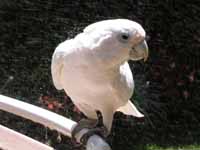
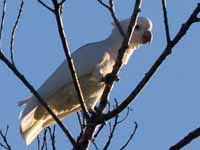
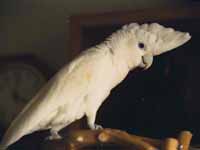
Cockatoo,_Philippine Cacatua haematuropygia
Description: The Philippine cockatoo, also known as red-vented cockatoo, has mainly white plumage, pale blue skin around eyes, and a whitish bill. It has a reddish lower-belly and reddish under-tail coverts. The under-wing and under-tail are yellow tinged. It is 30 to 31 cm long and 300 grams.
Range: Philippines.
Habitat: Previously mainly forest. After much deforestation, now mangroves, forests edges, and maize fields.
Diet: Seeds, fruits, nuts, berries, maize.
Conservation status: The Philippine cockatoo is listed as Critically Endangered because of deforestation and capture fot sales.
Image by: 1) Jacobusmulder - Palawan, Philippines 2) Palawan_Council_for_Sustainable_Development 3) Loury_CedricRange: Philippines.
Habitat: Previously mainly forest. After much deforestation, now mangroves, forests edges, and maize fields.
Diet: Seeds, fruits, nuts, berries, maize.
Conservation status: The Philippine cockatoo is listed as Critically Endangered because of deforestation and capture fot sales.
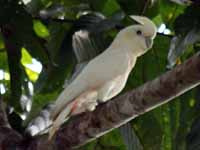
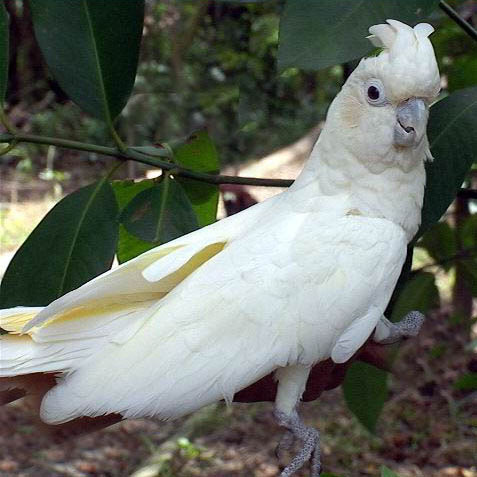

Cockatoo,_Salmon-crested Cacatua moluccensis
Description: The salmon-crested cockatoo, also known as the Moluccan cockatoo, has pinkish-white plumage and a salmon-colored crest. It has some yellow on the under-wing and the under-tail. There is a white eye-ring and the bill is black. It is 46 to 52 cm long and weighs up to 850 grams which makes it a large cockatoo.
Range: Moluccas in eastern Indonesia. Introduced to Oahu, Hawaii.
Habitat: Forests, especially primary.
Diet: Seeds, nuts, fruits. Also coconuts.
Conservation status: It is listed as Vulnerable because of habitat loss and hunting for captivity. The salmon-crested cockatoo is widely considered to be one of the most demanding parrots to keep as a pet due to their high intelligence, large size, loud calls (it is one of the loudest birds) and need to chew.
Image by: 1) Len_Charnoff 2) Adilson Borszcz 3) Len Charnoff Range: Moluccas in eastern Indonesia. Introduced to Oahu, Hawaii.
Habitat: Forests, especially primary.
Diet: Seeds, nuts, fruits. Also coconuts.
Conservation status: It is listed as Vulnerable because of habitat loss and hunting for captivity. The salmon-crested cockatoo is widely considered to be one of the most demanding parrots to keep as a pet due to their high intelligence, large size, loud calls (it is one of the loudest birds) and need to chew.
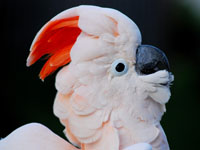
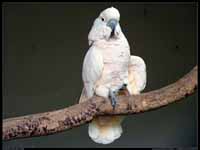
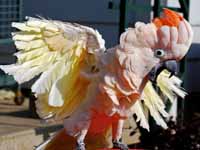
Cockatoo, Sulphur-crested Cacatua galerita
Description: The sulphur-crested cockatoo has mainly white plumage. The under-wing and under-tail are yellow tinged. It has a yellow crest, black bill, grey legs, and bluish-white eye-ring. The male has blackish eyes and the female has reddish or brown eyes. It is 44 to 55 cm long and weighs 800 to 950 grams. They live 20 to 40 years in the wild and up to 70 in captivity. They lay 2 to 3 eggs in a tree hollow and incubate them for 25 to 27 days. The similar blue-eyed cockatoo has a much bolder blue eye-ring than the sulphur-crested cockatoo.The sulphur-crested cockatoo is much larger than the yellow-crested cockatoo and it has a darker crest.
Range: North America (escapees), Australasia, Indonesia.
Habitat: Forests, cultivated crop land.
Diet: Seeds, fruits, buds and a variety of crops leading some to consider them pests.They are very intelligent and in Sydney, Australia they have learned how to open garbage bins as a source of food. The sulphur-crested cockatoo sometimes eats clay to detoxify food. When a flock is feeding on the ground, a sentry will be posted on a tree to give an alert if a predator is spotted.
Conservation status: Least Concern.
mage by: 1) Dick Daniels - Birds of Eden 2, 4) Dick - Sydney, Australia 3) Sandy Cole - Flamingo
Gardens in Florida Range: North America (escapees), Australasia, Indonesia.
Habitat: Forests, cultivated crop land.
Diet: Seeds, fruits, buds and a variety of crops leading some to consider them pests.They are very intelligent and in Sydney, Australia they have learned how to open garbage bins as a source of food. The sulphur-crested cockatoo sometimes eats clay to detoxify food. When a flock is feeding on the ground, a sentry will be posted on a tree to give an alert if a predator is spotted.
Conservation status: Least Concern.
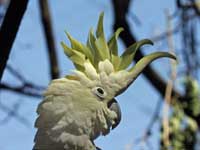
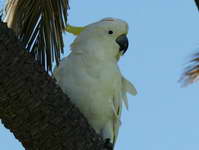

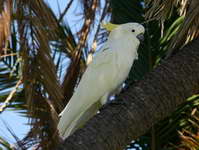
Cockatoo, White Cacatua alba
Description: The white cockatoo has mainly white plumage with some yellow on the under-wing and under-tail. It has a very impressive white crest which leads to its alternate name of umbrella cocatoo. The eyes are brown or black and the bill is dark grey. It is a medium sized cockatoo with an approximate length of 46 cm and an average weight of 550 grams. It usually lays 2 eggs, incubates for 28 days, and fledges after 84 days. Captive white cockatoos bond well with their owners.
Range: Indonesia.
Habitat: Lowland tropical forests.
Diet: Berries, seeds, nuts, fruits, roots.
Conservation status: The white cockatoo is listed as Endangered because of habitat loss and capture sales.
mage by: 1) Valerie_Everett 2) Dick Daniels - Jungle Island of Miami 3) viajar24h 4) Dick - Sylvan Heights Range: Indonesia.
Habitat: Lowland tropical forests.
Diet: Berries, seeds, nuts, fruits, roots.
Conservation status: The white cockatoo is listed as Endangered because of habitat loss and capture sales.

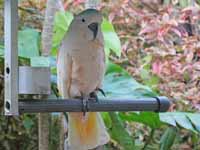
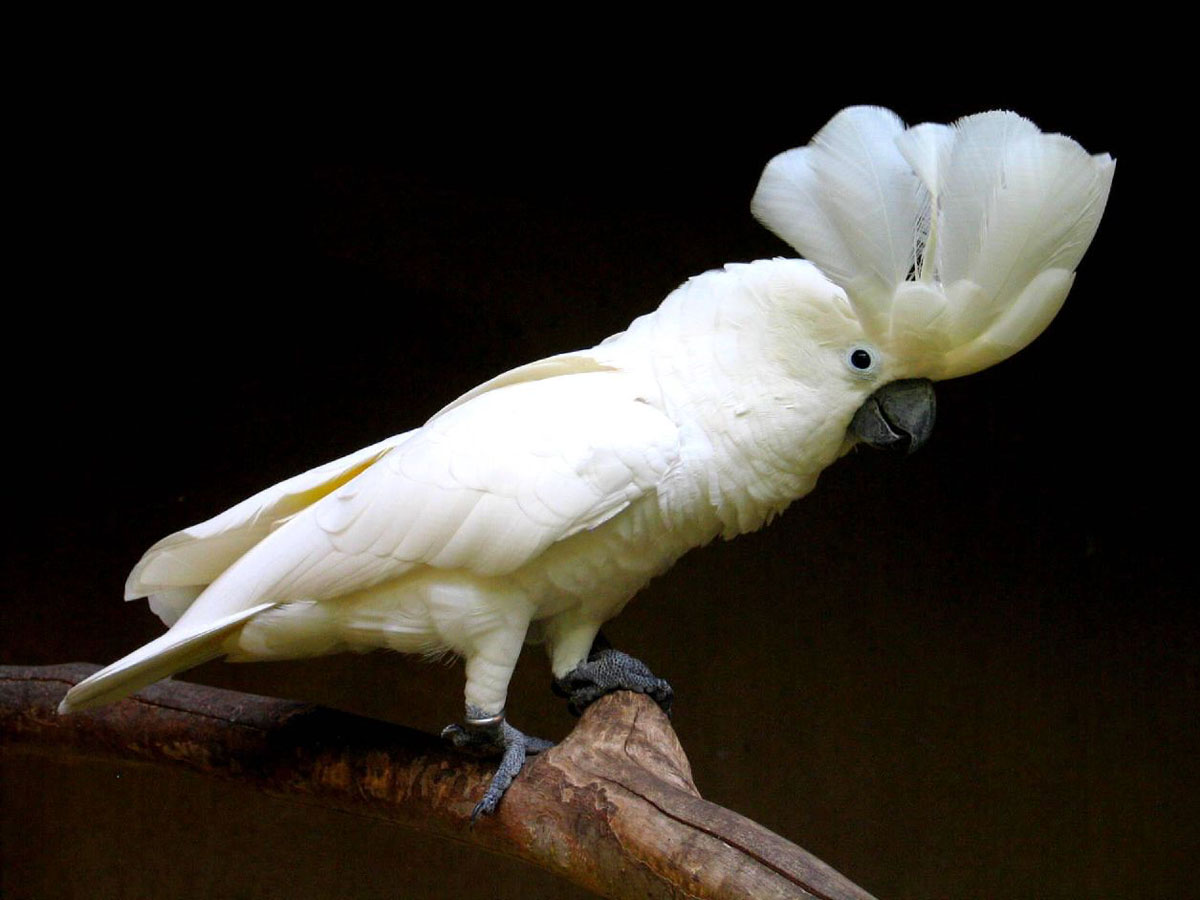
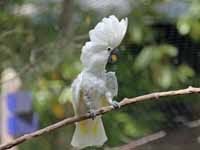
Cockatoo, Yellow-Crested Cacatua sulphurea
Description: The yellow-crested cockatoo has mainly white plumage including a yellow crest. It has bluish-white orbital skin, a black bill, and grey feet. It averages 33 cm long and weighs 350 grams.There are usually 2 eggs which are incubated for 28 days and the chicks fledge at 75 days.The similar blue-eyed cockatoo has a much bolder blue eye-ring than yellow-crested cockatoo. The sulphur-crested cockatoo is much larger than the yellow-crested cockatoo and it has a darker crest.
Range: Indonesia.
Habitat: Wooded and also cultivated areas.
Diet: Seeds, buds, fruits, nuts, and herbaceous plants.
Conservation status: The yellow-crested cockatoo is Critically Endangered due to illegal trapping for the cage-bird trade.
mage by: 1) Darren 2) Snowmanradio
3) Nicola Bonazzi - Sydney 4) Dick Daniels - Birds of Eden, South AfricaRange: Indonesia.
Habitat: Wooded and also cultivated areas.
Diet: Seeds, buds, fruits, nuts, and herbaceous plants.
Conservation status: The yellow-crested cockatoo is Critically Endangered due to illegal trapping for the cage-bird trade.
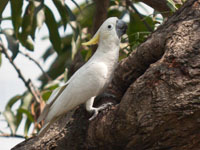
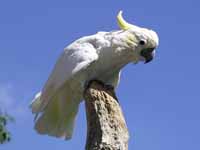
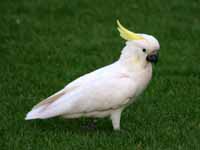

Corella,_Little Cacatua sanguinea
Description: The little corella has mainly white plumage, a blue eye-ring, and pink lores. It is 36 to 39 cm in length and weighs 430 to 580 grams.
Range: Australia, southern New Guinea.
Habitat: Scrub, grasslands, and grassy woodlands.
Diet: Seeds. buds, blossoms, insects, larvae.
Conservation status: Least Concern.
Image by: 1) Geoff_Whalan 2) Brett Donald 3) Gregory_SmithRange: Australia, southern New Guinea.
Habitat: Scrub, grasslands, and grassy woodlands.
Diet: Seeds. buds, blossoms, insects, larvae.
Conservation status: Least Concern.
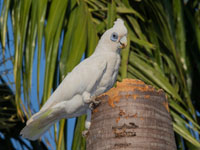
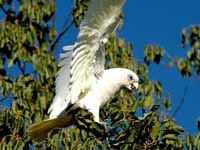
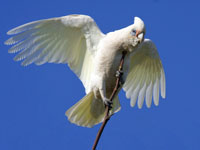
Corella,_Long-billed Cacatua tenuirostris
Description: The long-billed corella, also known as slender-billed corella, has mainly white plumage, blue orbital skin, and a reddish-pink face and forehead. It has a reddish-pink breast mark, yellowish under-wings, and yellowish under-tail. It has 2 to 3 eggs which incubates for about 24 days, and the chicks fledge after about 56 days. It is 37 to 40 cm longs and weights 500 to 600 grams.
Range: Australia.
Habitat: Woodlands.
Diet: Roots, seeds, bulbs.
Conservation status: Least Concern.
Image by:
1) Ron_Knight 2) patrickkavanagh 3) Melissa 4) David_JenkinsRange: Australia.
Habitat: Woodlands.
Diet: Roots, seeds, bulbs.
Conservation status: Least Concern.
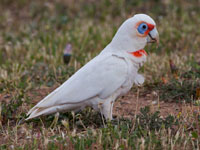

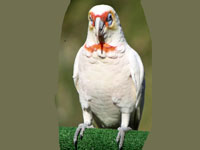

Corella, Tanimbar Cacatua goffiniana
Description: The Tanimbar corella has mainly white plumage, pink lores, yellow tinged under-wing, and yellow tinged under-tail. The bill is pale grey, the eyes brown to black, and the eye-rings are white. It is about 31 cm long and between 250 and 300 grams which makes it the smallest of the white cockatoos. The little corella and Tanimbar corella are similar, but their ranges do not overlap.
Range: Tanimbar Islands archipelago in Indonesia.
Habitat: Forests, cleared and cultivated lands.
Diet: Little known. It does eat maize from fields which some considered to make it a pest.
Conservation status: Because of habit loss, hunting, and its limited range, the Tanimbar corella is listed as Near Threatened.
Image by: 1) Sam at www.photos8.com 2) Lip Kee - Tanimbar Island, Indonesia 3) Green_Baron - Varsity ParkRange: Tanimbar Islands archipelago in Indonesia.
Habitat: Forests, cleared and cultivated lands.
Diet: Little known. It does eat maize from fields which some considered to make it a pest.
Conservation status: Because of habit loss, hunting, and its limited range, the Tanimbar corella is listed as Near Threatened.
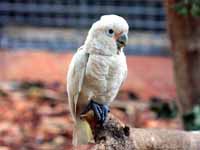
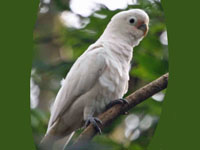
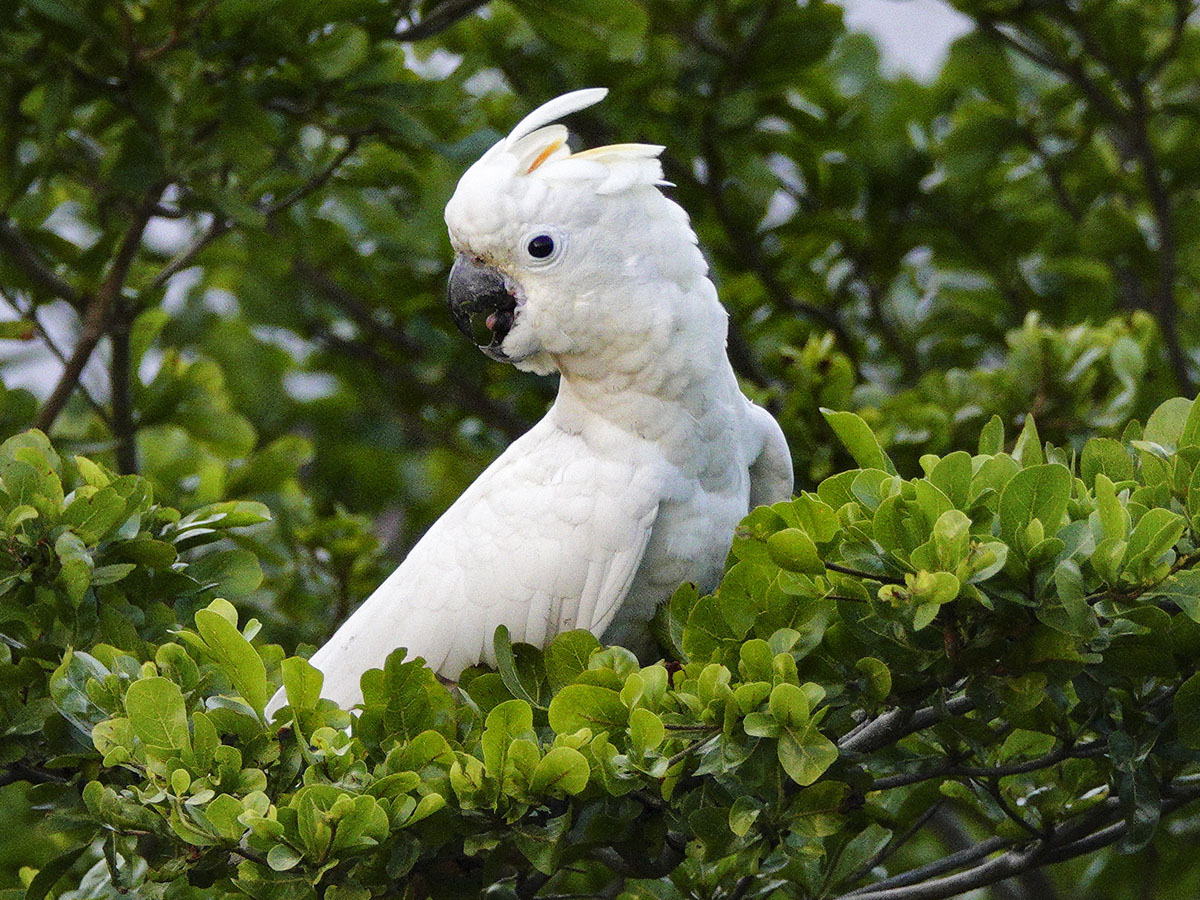
Corella, Western Cacatua pastinator
Description: The western corella has mainly white plumage, a large area of blue facial skin around the eyes, and pink lores. the under-tail is yellowish and the bill is pale. It is 37 to 45 cm long. Males weight about 700 grams and females 600 g. It has an average of 3 eggs, incubates for 22 to 23 days, and fledges in 53 to 67 days.
Range: southwest Australia.
Habitat: Forests, cleared and cultivated lands.
Diet: Seeds, wheat grain, bulbs, insect larvae.
Conservation status: Least Concern
Image by: 1) Steve Wilson - Blackpool Zoo, London 2) Steve Forsyth - PerthRange: southwest Australia.
Habitat: Forests, cleared and cultivated lands.
Diet: Seeds, wheat grain, bulbs, insect larvae.
Conservation status: Least Concern
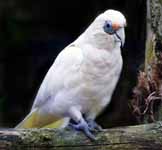
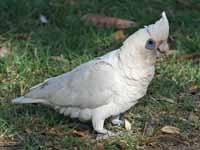
Genus Callocephalon - 1 species
Cockatoo, Gang-gang Callocephalon fimbriatum
Description: The gang-gang cockatoo has mainly grey plumage. The eyes are brown and the legs are grey. The male has a red head and crest. The female has a grey head and slight grey crest. It is 32 to 37 cm long and 280 grams. The female uses her bill to create a nest hole in young trees. There are usually 2 eggs and the incubation period 24 - 30 days.
Range: Coastal regions of south-eastern Australia.
Habitat: Cool and wet forests and woodlands.
Diet: Seeds, fruits, berries, insects and their larvae.
Conservation status: Least Concern.
Image by: 1, 4) David Cook - Wamboin, NSW, Australia 2)
Martyman - Australian National Botanic Gardens 3 Peter_ShanksRange: Coastal regions of south-eastern Australia.
Habitat: Cool and wet forests and woodlands.
Diet: Seeds, fruits, berries, insects and their larvae.
Conservation status: Least Concern.
1) Pair 2) Female 3, 4) Male
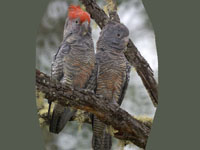
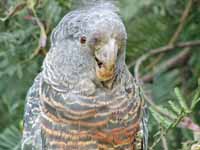
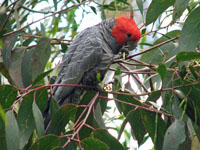
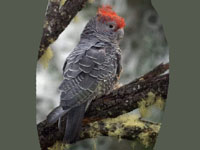
Genus Calyptorhynchus
These mainly black cockatoos are found in Australia.
Cockatoo, Glossy Black- Calyptorhynchus lathami
Description: The glossy black-cockatoo has mainly blackish plumage. It has a red tail band. At 46 to 50 cm long it is the smallest black cockatoo. The female has yellow spots on her head and also black bars on her tail band.
Range: Eastern Australia.
Habitat: Vicinity of she-oaks which are a pine-type tree.
Diet: Seeds on the cones of she-oaks.
Conservation status: Least Concern.
Image by: 1, 2) David Cook - Crowdy Bay National Park 3) Aviceda - Queensland Range: Eastern Australia.
Habitat: Vicinity of she-oaks which are a pine-type tree.
Diet: Seeds on the cones of she-oaks.
Conservation status: Least Concern.
1) Pair 2) Female 3) Male

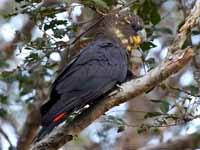
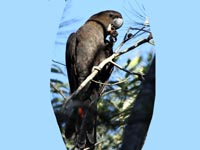
Cockatoo, Long-billed Black- Calyptorhynchus baudinii
Description: The long-billed black-cockatoo, also known as Baudin's cockatoo, has mainly dark-grey plumage with light grey scalloping. It has whitish ear coverts. It is 55 to 60 cm long and weighs 540 to 790 grams. The male has a mainly dark grey bill and pink eye-rings. The female has an ivory colored bill, grey eye-rings, and brown-grey legs. It has a longer and thinner bill than the similar short-billed black-cockatoo. Differentiation between these species in the field is difficult.
Range: southwestern Australia.
Habitat: Mainly forests of eucalyptus trees.
Diet: Mainly seeds; also insect larvae.
Conservation status: It is listed as Endangered because of a reduction of eucalyptus with hollows suitable for nests.
Image by: 1) Edward Lear 2, 3) Rick01 - Western AustraliaRange: southwestern Australia.
Habitat: Mainly forests of eucalyptus trees.
Diet: Mainly seeds; also insect larvae.
Conservation status: It is listed as Endangered because of a reduction of eucalyptus with hollows suitable for nests.
1, 2) Female 3) Male
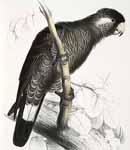
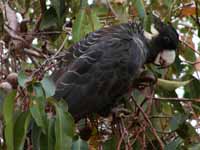
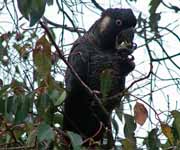
Cockatoo, Red-tailed Black- Calyptorhynchus banksii
Description: The red-tailed black-cockatoo has mainly black plumage. It has a light colored bill and some red panels on the tail. It is approximately 60 cm long and weighs 615 to 920 grams. It usually has 1 egg, incubates 28 to 32 days, and fledges in 10 to 12 weeks. The female has some yellowish-red spots. The red-tailed black-cockatoo is the most popular black cockatoo for captivity because of its adaptability.
Range: Australia.
Habitat: Eucalyptus woodlands, or along water courses.
Diet: Seeds, including large hard seeds from eucalyptus fruits.
Conservation status: Least Concern.
Image by: 1) gAbY 2) Laurie_Boyle 3) Geoff_Whalan - AU 4) Jean_and_FredRange: Australia.
Habitat: Eucalyptus woodlands, or along water courses.
Diet: Seeds, including large hard seeds from eucalyptus fruits.
Conservation status: Least Concern.
1) Male left; female right 2) Female 3, 4) Male
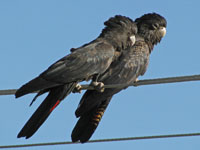
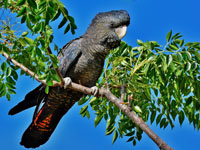
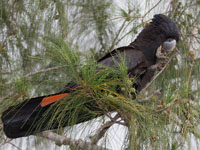
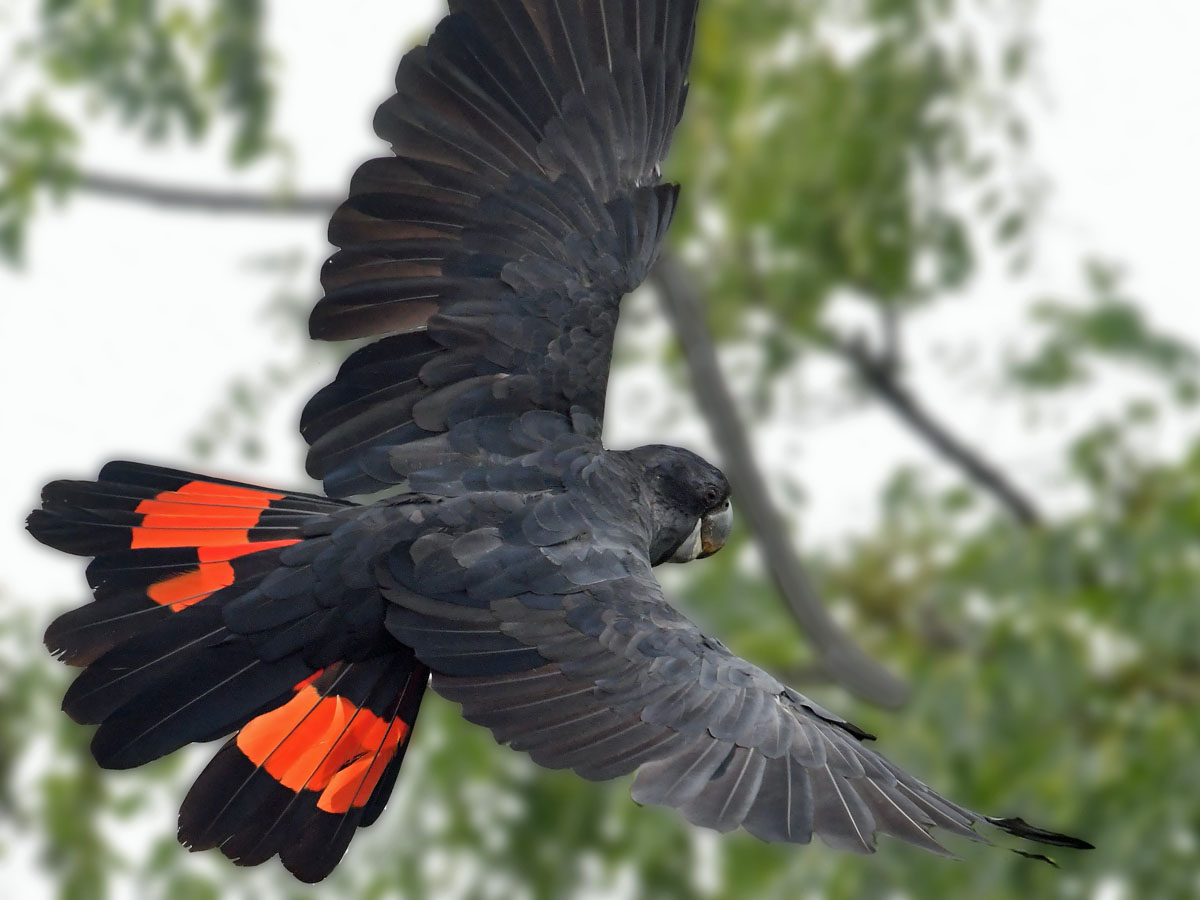
Cockatoo, Short-billed Black- Calyptorhynchus latirostris
Description: The short-billed black-cockatoo, also known as Carnaby's black-cockatoo, has mainly dark-grey plumage with light grey scalloping and whitish ear coverts. It is 55 to 60 cm long and weighs 580 to 770 grams. The male has a dark grey bill and pink eye-rings. The female has an ivory colored bill, grey eye-rings, and brown-grey legs. The long-billed black-cockatoo has a longer and thinner bill than the similar short-billed black-cockatoo. Differentiation between these species in the field is difficult.
Range: Southwestern Australia.
Habitat: Shrubland and eucalyptus woodlands.
Diet: Seeds of cones, Also flowers, insect larvae.
Conservation status: It is listed as Endangered because of habit loss its reduced range,
Image by: 1) Ralph Green - Perth 2, 3, 4) Laurie_BoyleRange: Southwestern Australia.
Habitat: Shrubland and eucalyptus woodlands.
Diet: Seeds of cones, Also flowers, insect larvae.
Conservation status: It is listed as Endangered because of habit loss its reduced range,
1, 2) Female 3, 4) Male
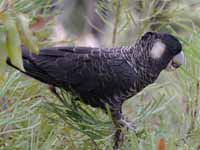
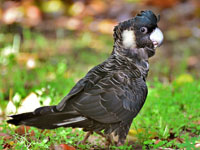

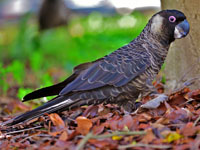
Cockatoo, Yellow-tailed Black Calyptorhynchus funereus
Description:The yellow-tailed black-cockatoo has mainly dark grey plumage, It also has yellowish ear coverts and a white tail band. It is 55 to 60 cm long and weighs 610 to 900 grams. The nest is in hollows of old trees. It has one or two eggs, incubates for 28 to 31 days, and fledges 3 months later. The male has dark a grey bill and pink eye-rings. The female has an ivory colored bill, grey eye-rings, and brown-grey legs.
Range: Australia.
Habitat: Temperate forests, forest edges, and clearings.
Diet: Seeds, wood boring grubs.
Conservation status: Least Concern.
Image by: 1) JJ Harrison in Tasmania Australia 2)
David Cook - Wamboin, NSW, Australia 3) Nik_Borrow - Tasmania 4) birdsaspoetryRange: Australia.
Habitat: Temperate forests, forest edges, and clearings.
Diet: Seeds, wood boring grubs.
Conservation status: Least Concern.
2) Male (via red eye-ring)

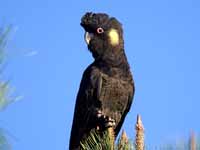
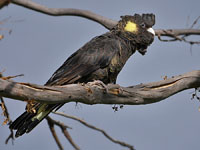
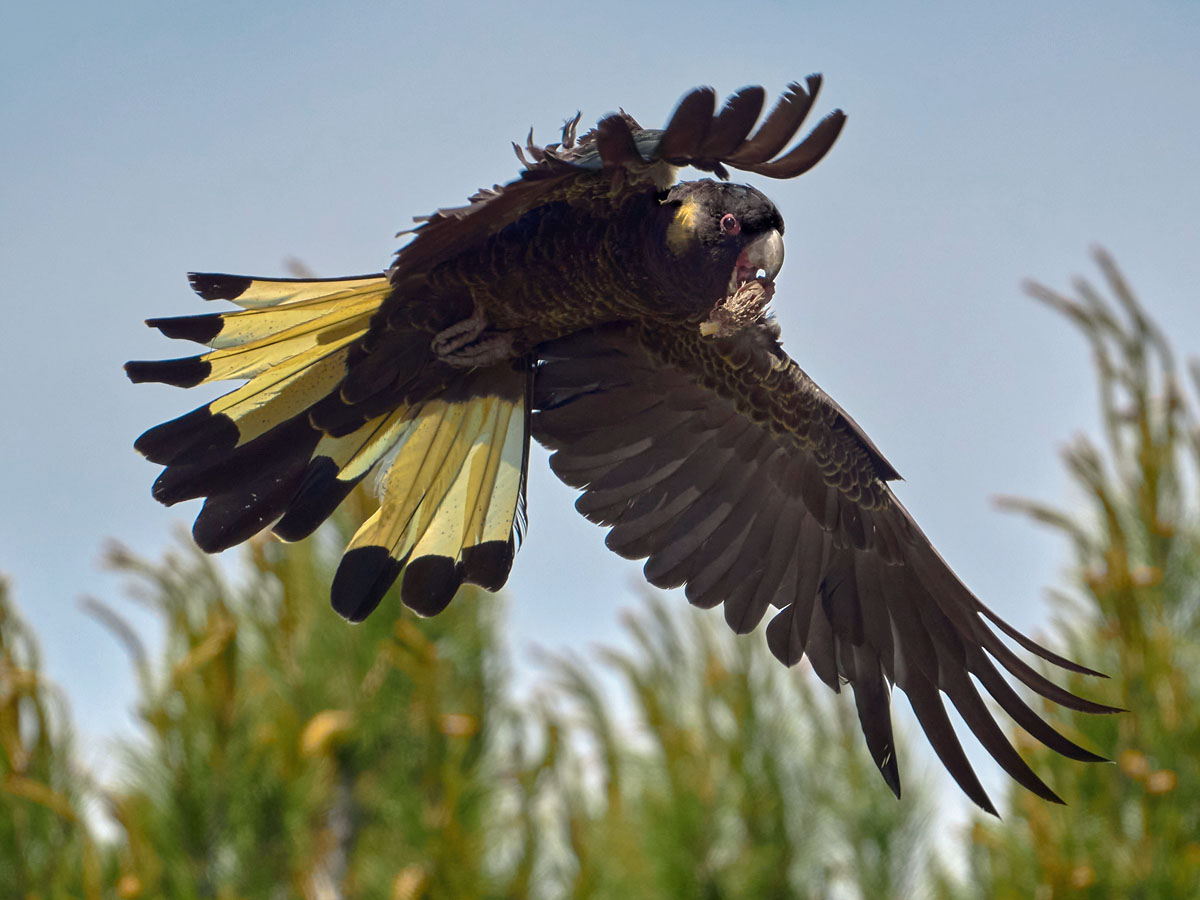
Genus Eolophus - 1 species
Galah Eolophus roseicapilla
Description: The galah, also known as rose-breasted cockatoo, has grey upperparts with lighter crown and crest;. The underparts are pinkish-grey and the bill is ivory colored. The adult has rough bare skin around the eyes; the juvenile just has bare skin. It is 35 cm long and weighs 270 to 350 grams.The mature female has red eyes. The galah will form large mixed flocks which include Major Mitchell's cockatoo, the little corella, and the sulphur-crested cockatoo. The galah readily hybridizes with all of these species. The galah has 2 to 5 eggs, incubates for 25 days, and fledges at 7 weeks.
Range: Australia.
Habitat: Previously grasslands and woodlands. Has adapted to croplands and parks.
Diet: Seeds, grains.
Conservation status: Least Concern.
Image by: 1) Dick Daniels - Australia 2) Dick - Jungle
Island of Miami 3) Alexandre_Roux 4) David Cook Range: Australia.
Habitat: Previously grasslands and woodlands. Has adapted to croplands and parks.
Diet: Seeds, grains.
Conservation status: Least Concern.
1) Juvenile

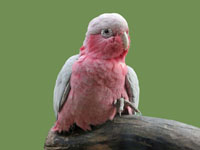
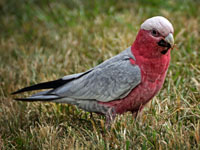
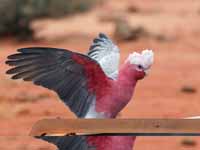
Genus Lophochroa - 1 species
Cockatoo, Pink Lophochroa leadbeateri
Description: The pink cockatoo, also known as Major Mithchell's cockatoo, has mainly pinkish-white plumage. It has a pink and orange crest. The mature female has red eyes and the female has brown.
Range: Australia.
Habitat: Arid and semi-arid inland areas. Large sized woodlands as they will not nest near other pink cockatoos.
Diet: Seeds, grains, insect larvae.
Conservation status: Least Concern.
Image by: 1) JJ_Harrison - New South Wales 2, 4) Nik_Borrow 3) Dick
Daniels - Sylvan
Heights Range: Australia.
Habitat: Arid and semi-arid inland areas. Large sized woodlands as they will not nest near other pink cockatoos.
Diet: Seeds, grains, insect larvae.
Conservation status: Least Concern.
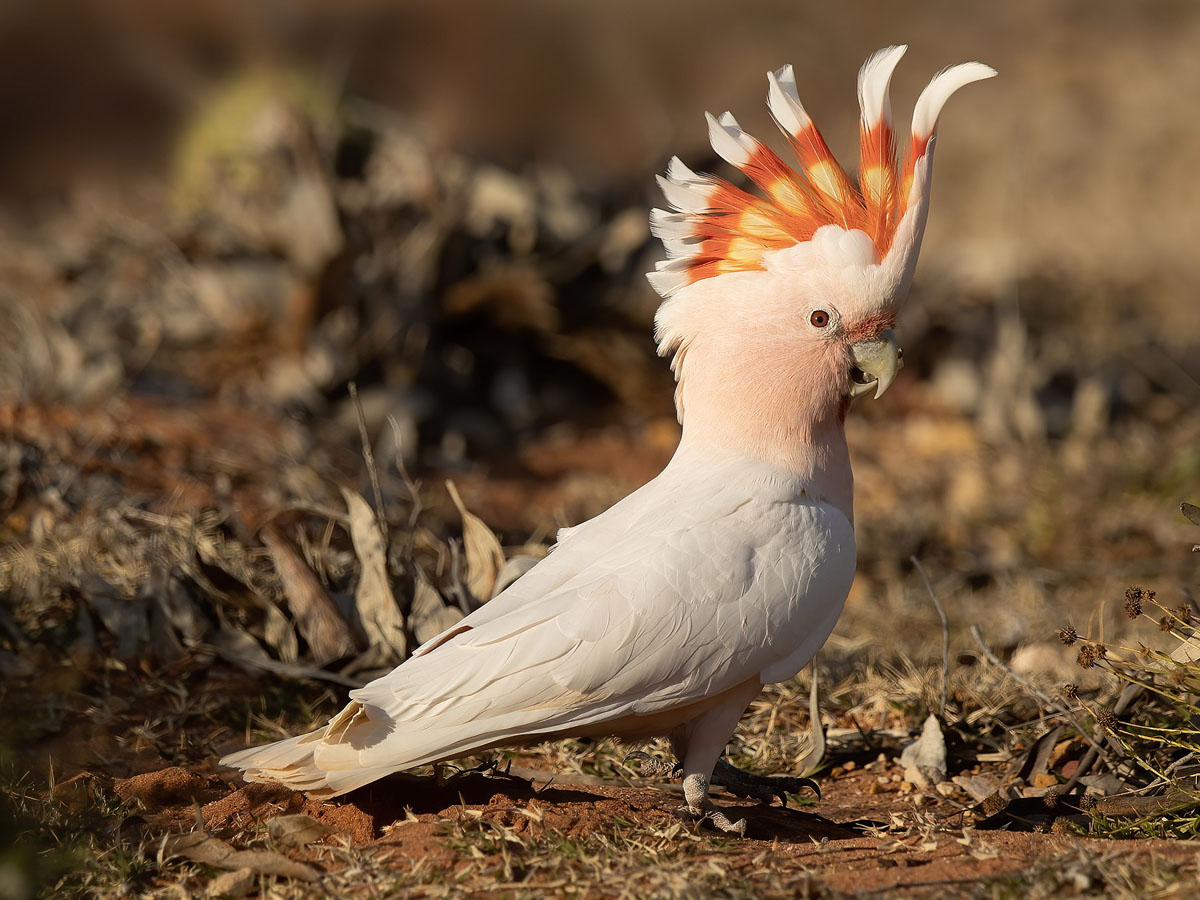
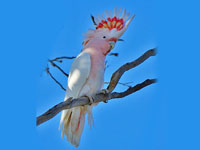
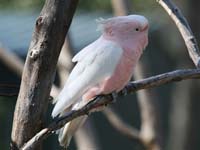
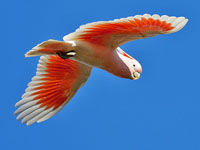
Genus Nymphicus - 1 species
Cockatiel Nymphicus hollandicus
Description: The cockatiel is a popular bird in aviculuture and many various colors have been developed. These have escaped into the wild and influenced that population. The wild type has primarily grey plumage and round orange ear coverts. It is 29 to 33 cm long and weights 80 to 100 grams. A wild male has a white or yellow face while the female has a greyer face.
Range: North America (escapees), Australia.
Habitat: Arid to semi-arid open areas with water available, open woodland, grasslands, croplands.
Diet: Seads. Prefers wild seeds, but eats enough cultivated seeds to be considered a pest.
Conservation status: Least Concern.
Image by: 1) Quimby 2) Dick Daniels - Birds of Eden 3) Ken and Nyetta 4) JesRange: North America (escapees), Australia.
Habitat: Arid to semi-arid open areas with water available, open woodland, grasslands, croplands.
Diet: Seads. Prefers wild seeds, but eats enough cultivated seeds to be considered a pest.
Conservation status: Least Concern.
1) Pair
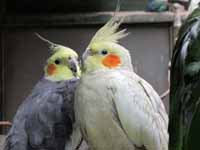
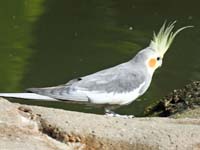
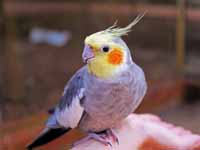
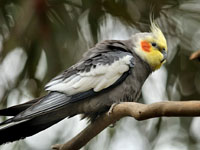
Genus Probosciger - 1 species
Cockatoo,_Palm Probosciger aterrimus
Description: The palm cockatoo is a large grey bird. It has a large grey crest, large bill, and a check patch of varying color, often red. It is 55 to 60 cm long and weighs 900 to 1200 grams. It is one of the largest cockatoo or parrot in Australia. It has usually one egg, incubates 30 to 35 days, and fledges 100 to 110 days.
Range: Australia.
Habitat: Most abundant in woodlands; also found in rainforests.
Diet: Seeds, fruits, nuts, berries.
Conservation status: Least Concern.
Image by: 1) Dick Daniels - Jungle Island of Miami 2) Arthur Chapman - Bird Park in Kuala
Lumpur 3) Chris_ChristnerRange: Australia.
Habitat: Most abundant in woodlands; also found in rainforests.
Diet: Seeds, fruits, nuts, berries.
Conservation status: Least Concern.
